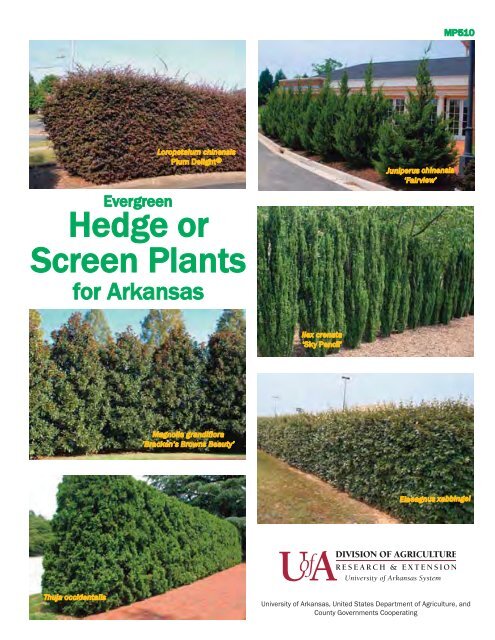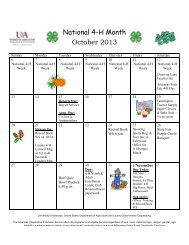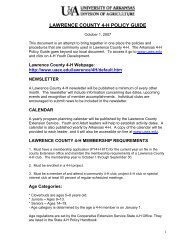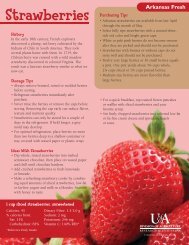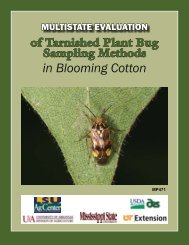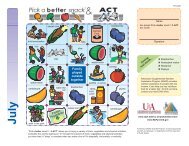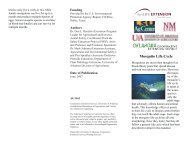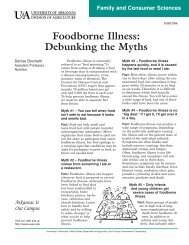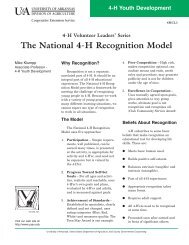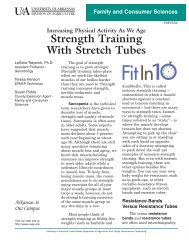Evergreen Hedge Or Screen Plants - University of Arkansas ...
Evergreen Hedge Or Screen Plants - University of Arkansas ...
Evergreen Hedge Or Screen Plants - University of Arkansas ...
Create successful ePaper yourself
Turn your PDF publications into a flip-book with our unique Google optimized e-Paper software.
MP510<br />
Loropetalum chinensis<br />
Plum Delight®<br />
Juniperus chinensis<br />
‘Fairview’<br />
<strong>Evergreen</strong><br />
<strong>Hedge</strong> or<br />
<strong>Screen</strong> <strong>Plants</strong><br />
for <strong>Arkansas</strong><br />
Ilex crenata<br />
‘Sky Pencil’<br />
Magnolia grandiflora<br />
‘Bracken’s Browns Beauty’<br />
Elaeagnus xebbingei<br />
DIVISION OF AGRICULTURE<br />
RESEARCH & EXTENSION<br />
<strong>University</strong> <strong>of</strong> <strong>Arkansas</strong> System<br />
Thuja occidentalis<br />
<strong>University</strong> <strong>of</strong> <strong>Arkansas</strong>, United States Department <strong>of</strong> Agriculture, and<br />
County Governments Cooperating
By:<br />
Dr. James A. Robbins<br />
Pr<strong>of</strong>essor and Extension Horticulture<br />
Specialist ‐ <strong>Or</strong>namentals<br />
<strong>University</strong> <strong>of</strong> <strong>Arkansas</strong> Division <strong>of</strong> Agriculture<br />
Little Rock, <strong>Arkansas</strong><br />
Acknowledgment: Thanks to Stan Brown <strong>of</strong> Blossomberry Nursery, Clarksville, <strong>Arkansas</strong>, for providing<br />
critical input into this publication.
Contents<br />
Alternative <strong>Hedge</strong>/<strong>Screen</strong> Options for Redtip Photinia and Leyland Cypress (table)......................<br />
5<br />
Broadleaf <strong>Evergreen</strong>s ....................................................................................................................................... 7<br />
Elaeagnus xebbingei .............................................................................................................................................. 7<br />
Ilex (Hollies) ............................................................................................................................................................. 7<br />
Ilex cornuta ‘Burfordii’ (Burford Chinese Holly) ............................................................................... 7<br />
Ilex crenata ‘Sky Pencil’ (Japanese Holly) ............................................................................................ 8<br />
Ilex opaca (American Holly) ....................................................................................................................... 8<br />
Ilex xattenuata ‘Fosteri’ (Foster Holly) .................................................................................................. 9<br />
Ilex x‘Emily Bruner’ (Emily Bruner Holly) ........................................................................................... 9<br />
Ilex xkoehneana (Koehne Holly) ............................................................................................................... 10<br />
Ilex x‘Nellie R. Stevens’ (Nellie R. Stevens Holly) ............................................................................... 10<br />
Ilex xOakland (Holly) .................................................................................................................................. 11<br />
Illicium parviflorum (Small‐Flowered Anise‐Tree) .................................................................................. 11<br />
Ligustrum japonicum (Japanese Privet/Waxleaf Privet) ....................................................................... 12<br />
Loropetalum chinense var. rubrum (Chinese Fringeflower) ................................................................. 12<br />
Magnolia grandiflora (Southern Magnolia) ................................................................................................ 13<br />
Magnolia virginiana (Sweetbay Magnolia) .................................................................................................. 13<br />
Michelia skinneriana (Banana‐shrub) ........................................................................................................... 14<br />
Myrica cerifera (Southern Waxmyrtle) ......................................................................................................... 14<br />
Osmanthus (Osmanthus) ..................................................................................................................................... 15<br />
Photinia serrulata (Chinese Photinia) ........................................................................................................... 15<br />
Prunus caroliniana (Carolina Cherrylaurel) ............................................................................................... 16<br />
Ternstroemia gymnanthera (Japenese Ternstroemia) ............................................................................ 16<br />
Viburnum awabuki ‘Chindo’ (Viburnum) ..................................................................................................... 17<br />
Viburnum odoratissimum (Viburnum) .......................................................................................................... 17<br />
Needle-Like <strong>Evergreen</strong>s ..................................................................................................................................<br />
Chamaecyparis thyoides (Atlantic Whitecedar) .........................................................................................<br />
Cryptomeria japonica (Japanese Cryptomeria) .........................................................................................<br />
Cupressus arizonica (Arizona Cypress) .........................................................................................................<br />
Cupressus sempervirens (Italian Cypress) ....................................................................................................<br />
Juniperus chinensis (Chinese Juniper) ...........................................................................................................<br />
Juniperus virginiana (Eastern Redcedar) .....................................................................................................<br />
Platycladus orientalis (<strong>Or</strong>iental Arborvitae) ...............................................................................................<br />
Podocarpus macrophyllus (Chinese Podocarpus) .....................................................................................<br />
Taxus cuspidata (Japanese Yew) ......................................................................................................................<br />
Thuja occidentalis (Eastern Arborvitae) .......................................................................................................<br />
Thuja x‘Green Giant’ (Arborvitae) ...................................................................................................................<br />
18<br />
18<br />
18<br />
19<br />
19<br />
20<br />
20<br />
20<br />
21<br />
21<br />
22<br />
22
<strong>Hedge</strong> or <strong>Screen</strong> <strong>Plants</strong><br />
for <strong>Arkansas</strong><br />
Historically, the two most common landscape<br />
plants used for hedge or screen purposes in<br />
<strong>Arkansas</strong> would be redtip photinia (Photinia<br />
xfraseri) or Leyland cypress (ΧCupressocyparis<br />
leylandii). While both <strong>of</strong> these plants are superb<br />
hedge or screen plants, both candidates are in<br />
decline due to disease problems. In the case <strong>of</strong><br />
redtip, the fungal problem is Entomosporium leaf<br />
spot (FSA6112, Leaf Spot <strong>of</strong> Redtip Photinia, at<br />
www.uaex.edu). In some cases, this disease can<br />
be so serious in <strong>Arkansas</strong> that a hedge will be<br />
leafless in June. Gardeners in states west and<br />
south <strong>of</strong> <strong>Arkansas</strong> <strong>of</strong>ten have less <strong>of</strong> a problem<br />
with this serious disease. The ever‐popular<br />
Leyland cypress has its own fungal problems<br />
(Seiridium and Botryosphaeria cankers) that<br />
make its future equally perilous (FSA7536,<br />
Branch Canker and Dieback <strong>of</strong> Leyland Cypress, at<br />
www.uaex.edu).<br />
Suggesting alternatives is no short order, and it<br />
would be misleading to assume that cookie‐cutter<br />
options lie in wait. However, there are a number <strong>of</strong><br />
plants that fit the mold fairly well (see the table).<br />
Alternative <strong>Hedge</strong>/<strong>Screen</strong> Options for <br />
Redtip Photinia and Leyland Cypress<br />
Genus<br />
Broadleaf <strong>Evergreen</strong>s<br />
Common Name<br />
USDA Cold<br />
Hardiness<br />
Zone z<br />
Growth Rate<br />
Height ×<br />
Width<br />
Elaeagnus xebbingei Elaeagnus 6-9 Very fast 15' × 15'<br />
Ilex cornuta<br />
‘Burfordii’<br />
Ilex crenata<br />
‘Sky Pencil’ or ‘Steeds’<br />
Burford Chinese Holly 6-9 Fast 18' × 15'<br />
Japanese Holly 6-8 Medium 8' × 15'<br />
Ilex opaca American Holly 5-9 Medium 35' × 15'<br />
Ilex xattenuata<br />
‘Fosteri’<br />
Foster Holly<br />
6-9 Medium<br />
25' × 10'<br />
Ilex x‘Emily Bruner’ Emily Bruner Holly 7-9 Fast 18' × 10'<br />
Ilex xkoehneana Koehne Holly (6b)7-9 Medium 20' × 12'<br />
Ilex x‘Nellie R. Stevens’ Nellie Stevens Holly 6-9 Fast 18' × 12'<br />
Ilex xOakland Holly 6-9 Medium 14' × 8'<br />
Illicium parviflorum Small Flowered Anise-tree 7-9 Medium 10' × 7'<br />
Ligustrum japonicum<br />
Japanese Privet<br />
Waxleaf Privet<br />
7-9 Medium-fast 12' × 12'<br />
Loropetalum chinense var. rubrum Chinese Fringeflower 7-9 Fast 10' × 10'<br />
Magnolia grandiflora Southern Magnolia 6-10 Medium-fast 30' × 10'<br />
z Cold hardiness zone 6b equates to Fayetteville, zone 7 to Little Rock and zone 8 to Hope, <strong>Arkansas</strong>.<br />
5
Genus<br />
Broadleaf <strong>Evergreen</strong>s (cont.)<br />
Magnolia virginiana<br />
‘Green Shadow’ or ‘Willowleaf Bay’<br />
Alternative <strong>Hedge</strong>/<strong>Screen</strong> Options <br />
for Redtip Photinia and Leyland Cypress<br />
Common Name<br />
USDA Cold<br />
Hardiness<br />
Zone z<br />
Growth Rate<br />
Height ×<br />
Width<br />
Sweetbay Magnolia 6-9 Medium 25' × 12'<br />
Michelia skinneriana Banana-Shrub 7-9 Medium to fast 8' × 8'<br />
Myrica cerifera Southern Waxmyrtle 7-11 Medium to fast 12' × 12'<br />
Osmanthus Osmanthus 6b-9 Slow to medium 12' × 12'<br />
Photinia serrulata Chinese Photinia 6-9 Very fast 20' × 20'<br />
Prunus caroliniana Carolina Cherrylaurel 7-10 Medium 15' × 12'<br />
Ternstroemia gymnanthera Japanese Ternstroemia 7-9 Slow to medium 9' × 9'<br />
Viburnum awabuki<br />
‘Chindo’<br />
Viburnum 7-9<br />
(south only)<br />
Viburnum odoratissimum Viburnum 8-10<br />
(south only)<br />
Needle-Like <strong>Evergreen</strong>s<br />
Chamaecyparis thyoides<br />
‘Rachel’ or ‘Emily’<br />
Medium to fast 15' × 5'<br />
Fast 12' × 12'<br />
Atlantic Whitecedar 4-9 Fast 25' × 12'<br />
Cryptomeria japonica Japanese Cryptomeria 5-8 Medium to fast 35' × 15'<br />
Cupressus arizonica<br />
‘Blue Ice’<br />
Cupressus sempervirens<br />
‘Stricta’<br />
Juniperus chinensis<br />
‘Fairview,’ ‘Keteleeri’ or ‘Iowa’<br />
Juniperus virginiana<br />
‘Idyllwild,’ ‘Manhattan Blue’ or ‘Taylor’<br />
Arizona Cypress 6-9 Very fast 35' × 15'<br />
Italian Cypress 7-9 Medium 20' × 2'<br />
Chinese Juniper 5-9 Fast 12' × 5'<br />
Eastern Redcedar 4-9 Fast 15' × 7'<br />
Platycladus orientalis <strong>Or</strong>iental Arborvitae 6-9 Medium variable<br />
Podocarpus macrophyllus Chinese Podocarpus 8-9<br />
(south only)<br />
Taxus cuspidata<br />
‘Capitata’ or ‘Pyramidalis’<br />
Thuja occidentalis<br />
‘Emerald’<br />
Medium 15' × 7'<br />
Japanese Yew 4-6<br />
Medium 12' × 6'<br />
(northwest only)<br />
Eastern Arborvitae 4-7 Slow to medium 15' × 5'<br />
Thuja x‘Green Giant’ Arborvitae 6-9 Very fast 30' × 8'<br />
z Cold hardiness zone 6b equates to Fayetteville, zone 7 to Little Rock and zone 8 to Hope, <strong>Arkansas</strong>.<br />
6
Broadleaf <strong>Evergreen</strong>s<br />
Elaeagnus xebbingei<br />
This plant, and the thorny elaeagnus (Elaeagnus pungens), are almost interchangeable. They are very<br />
fast‐growing plants that tolerate a range <strong>of</strong> soil types. The growth habit may be a concern to some. In the<br />
spring, this shrub throws <strong>of</strong>f very aggressive, unbranched stems all over the place that require frequent<br />
pruning. This plant is becoming a standard in most strip mall plantings. Unless pruned otherwise, this<br />
will be a large (15 feet tall by 15 feet wide), rounded shrub. One benefit <strong>of</strong> this plant is the extremely<br />
(equivalent to gardenia) fragrant flowers that develop in late fall.<br />
Elaeagnus xebbingei<br />
Ilex – Hollies<br />
What better genus to look for broadleaf evergreen options than the hollies. Other holly species such as<br />
Chinese holly (Ilex cornuta), Japanese holly (I. crenata) and yaupon holly (I. vomitoria) already serve as a<br />
backbone plant in most <strong>Arkansas</strong> landscapes. One major cultural consideration needs to be discussed. Most<br />
<strong>of</strong> the evergreen hollies are intolerant <strong>of</strong> poorly drained or heavy soils. If your soil fits this bill, consider<br />
another plant option or amend the soil appropriately. Remember that most hollies are either male or female<br />
plants; therefore, you must purchase a female selection if you want the colorful fruits. The major exceptions<br />
to this are ‘Nellie R. Stevens’ and ‘Burfordii,’ both <strong>of</strong> which set<br />
fruit without pollination.<br />
Ilex cornuta ‘Burfordii’ – Burford Chinese Holly<br />
Like ‘Nellie R. Stevens,’ this is a standard in the retail<br />
trade. It can be easily separated from ‘Nellie’ by looking at<br />
the number <strong>of</strong> sharp<br />
teeth on the leaf<br />
margin. ‘Burfordii’<br />
typically has fewer<br />
teeth. Burford holly<br />
will tend to be more<br />
rounded than some<br />
other hollies.<br />
Burford Chinese holly<br />
7
Ilex crenata ‘Sky Pencil’ – Japanese Holly<br />
This uniquely shaped Japanese holly was originally discovered in the wild on Mount Daisen in Japan.<br />
The plant was given to a group <strong>of</strong> plant collectors from the U.S in 1985. In 1992 it was distributed by the<br />
U.S. National Arboretum. In habit, it is similar to the upright form <strong>of</strong> Yaupon holly (I. vomitoria ‘Will<br />
Fleming’); however, ‘Sky Pencil’ splays less. Another cultivar, ‘Steeds,’ would also be a good choice for<br />
hedging. It is noticeably wider than ‘Sky Pencil’.<br />
‘Sky Pencil’ Japanese holly<br />
Ilex opaca (cultivars) – American Holly<br />
For those individuals who favor using native plants, the American holly provides a good option. Leaf<br />
color on American holly tends to be a lighter green compared to Chinese holly and Koehne holly. Several<br />
good selections are available including ‘Cardinal,’ ‘Merry Christmas’ and ‘Greenleaf.’<br />
American holly<br />
8
Ilex xattenuata ‘Fosteri’ – Foster Holly<br />
Foster holly is probably the most common cone‐shaped holly used in foundation plantings across<br />
<strong>Arkansas</strong>. It is typically not used as a hedge plant because <strong>of</strong> the pyramidal shape and lack <strong>of</strong> foliage<br />
density; however, it should not be overlooked for a s<strong>of</strong>t‐textured upright hedge.<br />
Foster holly<br />
Ilex x‘Emily Bruner’ – Emily Bruner Holly<br />
This is a dense, pyramidal‐shaped female clone with red fruits, and it is probably best suited to central<br />
and southern <strong>Arkansas</strong>.<br />
‘Emily Bruner’ holly<br />
9
Ilex xkoehneana – Koehne Holly<br />
While rare in the trade, this group <strong>of</strong> hybrid hollies would make an exceptional screening plant. The<br />
foliage is typically a very dark green, and the edge <strong>of</strong> the leaf is lined with distinctive teeth (serration). A<br />
number <strong>of</strong> worthy cultivars include ‘Hohman,’ ‘Wirt L. Winn’ and ‘Martha Berry.’<br />
‘Martha Berry’ holly<br />
Ilex x‘Nellie R. Stevens’<br />
‘Nellie R. Stevens’ is hard to beat for hedge or screen purposes. ‘Nellie’ is a large broadleaf evergreen with<br />
a pyramidal shape that can reach 20 feet. This holly is interesting in that it will set fruit without pollination.<br />
‘Nellie R. Stevens’ holly<br />
10
Ilex xOakland<br />
Plant Development Services in Loxley, Alabama, introduced Oakland. Oakland holds a tight pyramidal<br />
shape with absolutely no pruning. The leaves, which have a sharply serrated margin, hold a clean, deep<br />
green color year‐round.<br />
Oakland holly<br />
Illicium – Anise-Tree<br />
There are several good options when we mention Illicium. While they may not carry the same size and<br />
stature as redtip, they are still a worthy broadleaf evergreen option for a medium hedge. The <strong>University</strong> <strong>of</strong><br />
<strong>Arkansas</strong> Plant Evaluation Program evaluated the small anise‐tree (I. parviflorum), and the results were not<br />
stellar. Although trial plants survived in full sun, partial shade sites would be recommended in <strong>Arkansas</strong>.<br />
All plants died at the Fayetteville (zone 6b) test site during the winter <strong>of</strong> 2000‐2001. The statewide results<br />
are surprising since the small anise‐tree is a medium‐sized hedge that is a staple in the Atlanta, Georgia<br />
market. Anise‐tree is easy to identify by the aromatic smell its leaves emit when crushed.<br />
Anise-tree<br />
11
Ligustrum japonicum – Japanese Privet/Waxleaf Privet<br />
This privet has been available in the trade for many years. The leaves are dark green and appear<br />
“waxed.” Some may object to the unpleasant odor <strong>of</strong> the flowers. Waxleaf privet lends itself to shearing.<br />
Japanese privet<br />
Loropetalum chinense var. rubrum – Chinese Fringeflower<br />
Since their introduction to the retail trade in the late 1990s, the purple‐leafed forms (var. rubrum) <strong>of</strong><br />
Chinese fringeflower have made a pr<strong>of</strong>ound impact on our landscapes. Many <strong>of</strong> the non‐dwarf forms<br />
(Plum Delight ® , ‘Zhuzhou Fuchsia’ and ‘Blush’) would make an excellent sheared hedge in central and<br />
south <strong>Arkansas</strong>.<br />
Plum Delight ® Chinese fringeflower<br />
12
Magnolia grandiflora – Southern Magnolia<br />
Surprisingly, the Southern<br />
magnolia makes an excellent large<br />
screen. Several cultivars (‘Little<br />
Gem,’ ‘D. D. Blanchard,’ ‘Bracken’s<br />
Brown Beauty,’ Alta ® and ‘Hasse’)<br />
have a dense pyramidal form<br />
that lends itself well for this<br />
landscape purpose.<br />
‘D. D. Blanchard’ Southern magnolia<br />
Magnolia virginiana – Sweetbay Magnolia<br />
Sweetbay magnolia is an underutilized plant in<br />
<strong>Arkansas</strong>. The challenge when recommending it as a<br />
hedge plant is to find forms that have evergreen foliage<br />
(leaf retention can vary from deciduous to evergreen)<br />
and an upright growth habit. Most plants sold are grown<br />
from seed, so they will display variation in plant traits.<br />
For hedge or screen use, cultivars such as ‘Green<br />
Shadow’ or ‘Willowleaf Bay’ are worth the hunt.<br />
Sweetbay magnolia<br />
13
Michelia skinneriana – Banana-Shrub<br />
At some point in the near future, this will be renamed Magnolia skinneriana. The reason for suggesting<br />
this plant is based on its very favorable performance in the <strong>University</strong> <strong>of</strong> <strong>Arkansas</strong> Plant Evaluation<br />
Program. While not cold hardy in northwest <strong>Arkansas</strong>, this Michelia has been a top performer at Little Rock<br />
and Hope. Foliage is a very clean, medium green. <strong>Plants</strong> have a unique cream‐white flower that is mostly<br />
hidden by the evergreen foliage. Flowers with a sweet banana fragrance appear in early April and then<br />
sporadically through October. This plant would lend itself to serving as a medium‐sized hedge.<br />
Banana-shrub<br />
Myrica cerifera – Southern Waxmyrtle<br />
This is the southern version <strong>of</strong> the northern bayberry (M. pensylvanica). If you start in central <strong>Arkansas</strong><br />
and drive south into the tip <strong>of</strong> Florida, you will see the southern waxmyrtle more frequently the further<br />
south you drive. Central <strong>Arkansas</strong> should be its northern limit, and in years with severe winters, it may<br />
experience a setback in that zone. Texture on this plant is very fine due to thin twigs and narrow leaves.<br />
Crush the leaves and you will smell the classic bayberry candle fragrance. Myrica pensylvanica, the northern<br />
bayberry, is a possible hedge suggestion for the northwest corner <strong>of</strong> <strong>Arkansas</strong>.<br />
Southern waxmyrtle<br />
14
Osmanthus<br />
Certainly this genus is a worthy suggestion for a great hedge or screen plant, even though most species<br />
tend to be a bit more rounded and much slower‐ growing than redtip photinia. Osmanthus are known for<br />
extremely fragrant flowers. The Osmanthus seem to get no respect because they are easily confused with<br />
other genera. The little‐used Devilwood (O. americanus) could fool many as a privet (Ligustrum) since the<br />
leaf margin lacks serration. Others like O. xfortunei (Fortune’s osmanthus; O. heterophyllus x O. fragrans)<br />
and O. heterophyllus (Holly osmanthus) look like hollies because <strong>of</strong> the serrated leaf margins. There is an easy<br />
way to distinguish Osmanthus from hollies: leaf arrangement on Osmanthus is opposite and alternate to Ilex.<br />
Osmanthus xfortunei<br />
Photinia serrulata – Chinese Photinia<br />
This is actually one <strong>of</strong> the parents <strong>of</strong> the redtip hybrid. This plant is seen all over central and south<br />
<strong>Arkansas</strong>, but it is restricted to older landscapes. It is suggested that when redtip hit the market in the late<br />
’50s, people stopped purchasing the larger Chinese photinia. Chinese photinia is clearly a much larger<br />
(20 feet tall by 20 feet wide) and more rounded plant than redtip. A number <strong>of</strong> people will show disfavor<br />
for this plant since the flowers have an unpleasant odor. The flower display is exceptional in late<br />
March/early April followed by a nice display <strong>of</strong> dull red fruits borne in large clusters. Emerging foliage is<br />
more <strong>of</strong> a muted red in contrast to the striking red <strong>of</strong> redtip. Leaf spot fungus is not as serious on this plant.<br />
This species may be difficult to find in the retail trade. The Japanese photinia (P. glabra) would also be a<br />
good plant to consider but may be just as susceptible to leaf spot as redtip.<br />
Chinese photinia<br />
15
Prunus caroliniana – Carolina Cherrylaurel<br />
Many <strong>Arkansas</strong> gardeners are familiar with this species as a native plant or large, almost tree‐like<br />
broadleaf evergreen in older landscapes. Nurseries have introduced several improved selections including<br />
Bright ’N Tight (‘Monus’) from Monrovia Nursery. The 1/3‐inch diameter black fruits are readily spread<br />
by birds.<br />
Carolina cherrylaurel<br />
Ternstroemia gymnanthera – Japanese Ternstroemia<br />
Most retailers still sell this plant under the genus name Cleyera. In the past, Ternstroemia was primarily<br />
grown from seed, which resulted in a great deal <strong>of</strong> variation in habit that was not good for formal hedges.<br />
Several nurseries select and propagate improved selections from cuttings. Some <strong>of</strong> these new selections<br />
include LeAnn and Bronze Beauty. The new foliage on many <strong>of</strong> these is an attractive deep red, somewhat<br />
reminiscent <strong>of</strong> redtip photinia. Most <strong>of</strong> these tend to be rounder than redtip photinia with a mature size <strong>of</strong><br />
9 feet tall by 9 feet wide. The growth rate <strong>of</strong> Ternstroemia will not be as fast as some other hedge options.<br />
LeAnn Japanese ternstroemia<br />
16
Viburnum awabuki ‘Chindo’<br />
While this broadleaf evergreen is relatively unknown in <strong>Arkansas</strong>, it is hugely popular as a<br />
hedge/screen plant in the Southeast. It has very dark green almost waxed leaves. Based on <strong>University</strong> <strong>of</strong><br />
<strong>Arkansas</strong> Plant Evaluation Program results and field observations, this broadleaf evergreen is best suited to<br />
south <strong>Arkansas</strong>. The plant is not cold hardy in northwest <strong>Arkansas</strong>.<br />
‘Chindo’ viburnum<br />
Viburnum odoratissimum – Viburnum<br />
This broadleaf evergreen viburnum should display some winter injury in central <strong>Arkansas</strong>; however,<br />
due to its very fast growth, viburnum should recover quickly in the spring. Most reliable in south <strong>Arkansas</strong>.<br />
Viburnum odoratissimum<br />
17
Needle-Like <strong>Evergreen</strong>s<br />
Chamaecyparis thyoides ‘Emily’ (Webb #1) and ‘Rachel’ (Webb #2) – Atlantic Whitecedar<br />
This plant performed exceptionally well in the<br />
<strong>University</strong> <strong>of</strong> <strong>Arkansas</strong> Plant Evaluation Program. The<br />
plant looks very much like the native eastern redcedar. The<br />
species is unique in that it tolerates wet, boggy sites in the<br />
wild. It is a very fast‐growing plant and appears to be not<br />
quite as narrow as ‘Green Giant’ arborvitae.<br />
‘Emily’ Atlantic whitecedar<br />
Cryptomeria japonica – Japanese Cryptomeria<br />
This needle‐like evergreen, while used on a limited<br />
basis in <strong>Arkansas</strong>, seems to perform fairly well. Growth<br />
rate is medium, and the cone‐shaped plant should reach<br />
30 to 40 feet tall. The texture <strong>of</strong> the plant lends itself to<br />
<strong>Or</strong>iental gardens. ‘Yoshino’ is likely the most common<br />
selection in the trade. Other full‐sized forms include<br />
‘Elegans,’ ‘Ben Franklin’ and ‘Viridis.’<br />
Japanese cryptomeria<br />
18
Cupressus arizonica – Arizona Cypress<br />
This appears to be an excellent screen plant for full sun locations. While needle color on the species is a<br />
gray‐green, most cultivars have an eye‐catching silver‐blue/powder‐blue color. The blue hue is even better<br />
than what you get with the blue atlas cedar (Cedrus atlantica ‘Glauca’). Some <strong>of</strong> the blue foliage forms<br />
include ‘Blue Ice,’ ‘Blue Pyramid,’ ‘Carolina Sapphire,’ ‘Cook’s Peak’ and ‘Silver Smoke.’ ‘Blue Ice’ and ‘Blue<br />
Pyramid’ may have a much tighter pyramidal habit than ‘Carolina Sapphire.’ ‘Carolina Sapphire’ is a popular<br />
cut Christmas tree in <strong>Arkansas</strong>. This needle‐like evergreen grows faster than Leyland cypress. In general,<br />
the plant is free <strong>of</strong> serious insect and disease problems. Bagworms will be more common on ‘Carolina<br />
Sapphire’ than ‘Blue Ice.’<br />
The growth habit <strong>of</strong> young plants is very similar to our native eastern<br />
redcedar (Juniperus virginiana). Because needles are not borne in flat<br />
sprays like Leyland cypress, the overall texture is very s<strong>of</strong>t. <strong>Plants</strong> are<br />
clearly taller than they are wide and pyramidal in shape. As the plant<br />
matures, it will open up. Very old specimens almost have a weeping, graceful<br />
pyramidal appearance. Arizona cypress thrives on full sun in exposed<br />
situations. While<br />
constant moisture<br />
might promote<br />
growth, an established<br />
plant should<br />
tolerate fairly dry<br />
conditions. Avoid<br />
wet spots.<br />
‘Blue Ice’ <br />
Arizona cypress<br />
Cupressus sempervirens ‘Stricta’ – Italian Cypress<br />
While not that common in <strong>Arkansas</strong>, the extremely columnar<br />
growth habit makes this plant easy to identify in the landscape.<br />
The Italian cypress is likely best suited to central and<br />
southern <strong>Arkansas</strong>.<br />
Italian cypress<br />
19
Juniperus chinensis – Chinese Juniper<br />
Chinese junipers range in habit from low,<br />
spreading shrubs to large, upright plants. A<br />
number <strong>of</strong> cultivars would be useful as hedge or<br />
screen plants. Needle color will vary from a green<br />
(‘Fairview’ and ‘Keteleeri’) to a blue‐green (‘Iowa’).<br />
Be forewarned, Chinese juniper tends to be susceptible<br />
to fungal tip blights (Phomopsis, Kabatina)<br />
in <strong>Arkansas</strong>.<br />
Juniperus virginiana – Eastern Redcedar<br />
Although our native landscape is swarming<br />
with Eastern redcedar, this plant is not as common<br />
in our retail trade. A number <strong>of</strong> excellent cultivars<br />
(‘Idyllwild’, ‘Manhattan Blue’ and ‘Taylor’) are good<br />
choices for a large screen or hedge.<br />
‘Keteleeri’<br />
Chinese juniper<br />
‘Manhattan Blue’<br />
Eastern redcedar<br />
Platycladus orientalis (formerly Thuja orientalis) – <strong>Or</strong>iental Arborvitae<br />
This is essentially the southern<br />
version <strong>of</strong> the eastern arborvitae. The<br />
typical form is a large, rounded shrub,<br />
but specific upright cultivars are<br />
available at your local garden center.<br />
<strong>Or</strong>iental arborvitae<br />
20
Podocarpus macrophyllus – Chinese Podocarpus<br />
The Chinese podocarpus, with its needle‐like foliage, is<br />
gaining popularity in south <strong>Arkansas</strong>. The foliage looks very<br />
much like a yew (Taxus). If you plan to use this plant for hedge or<br />
screen purposes, make sure you select an upright form. Exposure<br />
should be full sun to partial sun.<br />
Chinese podcarpus<br />
Taxus cuspidata – Japanese Yew<br />
Upright forms <strong>of</strong> the Japanese yew are frequently used in the Upper Midwest and the East Coast as<br />
hedges. Upright growing cultivars such as ‘Capitata’ and ‘Pyramidalis’ work best for that purpose. Yews are<br />
frequent‐ly sheared to provide a formal look in the landscape. Japanese yew is best suited for shaded locations<br />
in northwest <strong>Arkansas</strong>. Another option for northwest <strong>Arkansas</strong> is the Canadian hemlock (Tsuga<br />
canadensis). If left unpruned, hemlock will be a medium‐sized tree that may grow to 50 feet.<br />
‘Flushing’ yew<br />
Eastern hemlock<br />
21
Thuja occidentalis ‘Emerald’ or ‘Smaragd’ – Eastern Arborvitae<br />
This needle‐like evergreen is the most common hedge or screen plant in the Pacific Northwest and<br />
Midwest. It is known for its beautiful emerald green color and tight, upright growth habit. Because it lacks<br />
heat tolerance, it is a better choice in northwest <strong>Arkansas</strong> than in central and south <strong>Arkansas</strong>. Eastern<br />
arbor vitae is more tolerant <strong>of</strong> shade than many other needle‐like evergreens.<br />
‘Emerald’ Eastern arborvitae<br />
Thuja x‘Green Giant’ – Arborvitae<br />
Introduced to the retail trade in the early 2000s, this is essentially an eastern arborvitae on steroids!<br />
This strongly pyramidal evergreen grows very fast. Once established, this plant should grow at least 2 feet<br />
per year. Mail‐order catalogs suggest ‘Green Giant’ is deer resistant. Because it is an arborvitae, people<br />
always question whether it is susceptible to attack by bagworms. Based on results from the <strong>University</strong> <strong>of</strong><br />
<strong>Arkansas</strong>, this plant is very susceptible to that insect. The trial also indicates that this plant is not tolerant <strong>of</strong><br />
very wet soils. Preferred<br />
exposure would be full<br />
sun to partial shade.<br />
‘Green Giant’ grows so fast<br />
that the central leader<br />
does not fill‐in until the<br />
following year. ‘Green<br />
Giant’ may also be sold in<br />
the trade as ‘Giganteoides’<br />
or ‘Spring Grove.’ The<br />
extreme heat in 2012<br />
demonstrated that ‘Green<br />
Giant’ is not as heat tolerant<br />
as some evergreens<br />
such as Arizona cypress or<br />
Eastern redcedar.<br />
‘Green Giant’ arborvitae<br />
22
Printed by <strong>University</strong> <strong>of</strong> <strong>Arkansas</strong> Cooperative Extension Service Printing Services.<br />
Issued in furtherance <strong>of</strong> Cooperative Extension work, Acts <strong>of</strong> May 8 and June 30, 1914, in cooperation with the U.S. Department <strong>of</strong><br />
Agriculture, Director, Cooperative Extension Service, <strong>University</strong> <strong>of</strong> <strong>Arkansas</strong>. The <strong>Arkansas</strong> Cooperative Extension Service <strong>of</strong>fers its<br />
programs to all eligible persons regardless <strong>of</strong> race, color, national origin, religion, gender, age, disability, marital or veteran status, or<br />
any other legally protected status and is an Affirmative Action/Equal Opportunity Employer.<br />
MP510‐PD‐10‐12N


